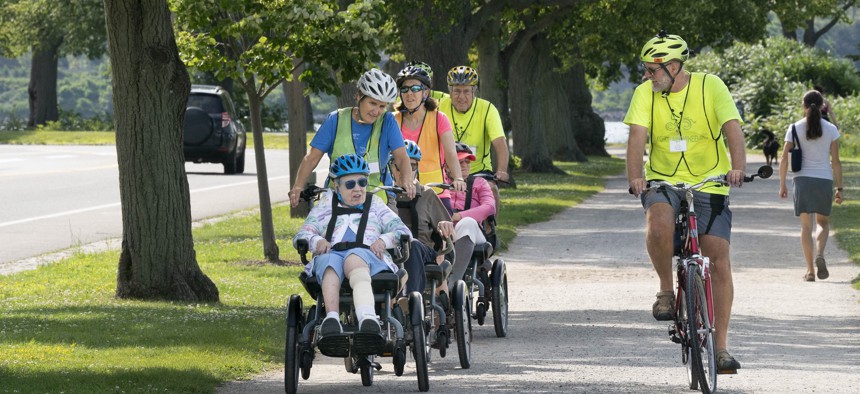$45M for New Trails Grants Included in Federal Funding Deal

Cyclists use the Back Cove Trail in Portland, Maine, in 2019. Gregory Rec/Portland Portland Press Herald via Getty Images
Cycling and pedestrian advocates had pressed for more, but say the money included in the legislation would be a good start.
Congress is moving forward with plans to spend $45 million on a new program that will help communities build paths or connect existing trails for cyclists and pedestrians.
Funding for the grants is tucked into a 4,155-page spending bill now moving on Capitol Hill. Congressional leaders hope the deal will reach President Biden by Friday, in order to prevent a government shutdown.
The $45 million for trail improvements is a victory for advocates, because it is the first time the federal government will fund this kind of program. But it is well short of the $200 million a year that Congress authorized when it passed last year’s infrastructure law, and even farther from the $500 million that advocates originally hoped for.
“It’s no secret that we were going into reauthorization asking for a lot more resources than this,” said Kevin Mills, vice president of policy for the Rails-to-Trails Conservancy. “But that doesn’t take away from the significance of this day. We’ve got the opportunity to start doing things the right way.”
He hopes enough communities express interest in the program that Congress will increase the annual funding to $200 million next year. (Even though Congress is now trying to settle on spending for the current fiscal year, the Biden administration is already working on its proposal for the budget cycle that starts next Oct. 1.)
The Active Transportation Infrastructure Investment Program is designed to help develop paths and trails with the same kind of planning and transportation goals now used for roads and railways, Mills said.
Bike and pedestrian trails are increasingly popular, but communities can only usually develop them in a piecemeal fashion when opportunities arise. The new grants will help with both planning and construction, so that communities can more intentionally build cycling and walking trails that will address residents’ needs.
That could mean linking existing trails to popular destinations, like city centers, job sites, parks or tourist attractions. It might involve connecting existing trails with each other.
“It’s making that switch from thinking of it as a nice-to-have-amenity and only thinking of it as a recreational asset to saying, ‘This has to be part of the fabric of the community. We have to make it safe, convenient and enjoyable,’” Mills said. “That psychological switch is going to be key for taking this more seriously.”
The Rails-to-Trails Conservancy has already helped eight metro areas develop plans for extensive cycling and pedestrian networks, he noted. In the Philadelphia area, for example, planners are working on a network of 30 pathways that would link both the Pennsylvania and New Jersey sides of the Delaware River. When it is complete, half of the region’s 3.1 million residents would live within a mile of one of the trails.
The Federal Highway Administration will administer the grants and determine the criteria for awarding them. States or individual communities will be able to apply for the grants. In most cases, they will require local matching funds, but the FHWA can grant hardship exemptions for communities that can’t afford the local share.
Mills said the goal is to build “low-stress connectivity,” where cyclists and pedestrians are separated from motor vehicles. The plans might incorporate some low-speed streets where bikes and cars share the road, he said, “but you’re not going to pretend a dangerous arterial isn’t, if you haven’t done something to make it safer.”
Daniel C. Vock is a senior reporter for Route Fifty based in Washington, D.C.
NEXT STORY: How states integrate GIS and elections






